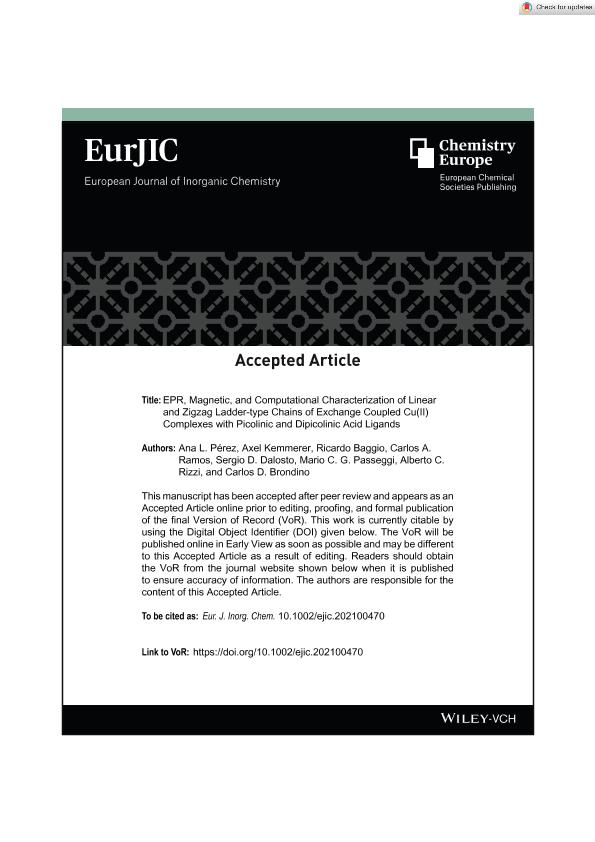Mostrar el registro sencillo del ítem
dc.contributor.author
Pérez, Ana Laura

dc.contributor.author
Kemmerer, Axel

dc.contributor.author
Baggio, Ricardo Fortunato

dc.contributor.author
Ramos, Carlos A.
dc.contributor.author
Dalosto, Sergio Daniel

dc.contributor.author
Passeggi, Mario Cesar Guillermo

dc.contributor.author
Rizzi, Alberto Claudio

dc.contributor.author
Brondino, Carlos Dante

dc.date.available
2022-10-18T11:21:19Z
dc.date.issued
2021-09-14
dc.identifier.citation
Pérez, Ana Laura; Kemmerer, Axel; Baggio, Ricardo Fortunato; Ramos, Carlos A.; Dalosto, Sergio Daniel; et al.; EPR, Magnetic, and Computational Characterization of Linear and Zigzag Ladder‐type Chains of Exchange Coupled Cu(II) Complexes with Picolinic and Dipicolinic Acid Ligands; Wiley VCH Verlag; European Journal of Inorganic Chemistry; 2021; 40; 14-9-2021; 4183-4195
dc.identifier.issn
1434-1948
dc.identifier.uri
http://hdl.handle.net/11336/173691
dc.description.abstract
We report magnetic, EPR, and computational studies on two representative examples of structurally well-characterized one dimension (1D) molecular systems: the copper complexes catena-[bis(μ-pyridine-2-carboxylato)-copper dihydrate] and catena-[(μ2-pyridine-2,6-dicarboxylato)-diaqua-copper(II)], hereafter 1 and 2, respectively. Experimental and theoretical results confirmed that the structural chains in both compounds behave as magnetic chains in which the copper ions are weakly coupled by isotropic exchange. Magnetic susceptibility measurements of 1 suggested that the copper ions are antiferromagnetically coupled whereas EPR measurements suggested ferromagnetic coupling at temperature above 100 K which becomes antiferromagnetic at low temperatures. Computational calculations would indicate that the ferromagnetic-antiferromagnetic change may be due to dCu−Oap shortening on lowering temperature temperature (a fact that was observed experimentally by XRD at low temperatures), which redistributes the small Cu(II) unpaired spin density delocalized on the apical ligand to copper. The 1D magnetic behavior of the zigzag ladder chain of 2 is less detectable than that of the single chain of 1. Magnetic susceptibility measurements in conjunction with computational calculations showed that the pathways that give rise to the 1D ladder transmit ferromagnetic exchange interactions with different strengths, with the stronger interaction being transmitted along the rungs. The role of the weaker exchange interactions transmitted along the rails on the magnetic dimensionality of 2 is analyzed.
dc.format
application/pdf
dc.language.iso
eng
dc.publisher
Wiley VCH Verlag

dc.rights
info:eu-repo/semantics/openAccess
dc.rights.uri
https://creativecommons.org/licenses/by-nc-sa/2.5/ar/
dc.subject
COPPER
dc.subject
EPR
dc.subject
EXCHANGE INTERACTION
dc.subject
MAGNETIC CHAIN
dc.subject
ONE DIMENSION SYSTEM
dc.subject.classification
Química Inorgánica y Nuclear

dc.subject.classification
Ciencias Químicas

dc.subject.classification
CIENCIAS NATURALES Y EXACTAS

dc.title
EPR, Magnetic, and Computational Characterization of Linear and Zigzag Ladder‐type Chains of Exchange Coupled Cu(II) Complexes with Picolinic and Dipicolinic Acid Ligands
dc.type
info:eu-repo/semantics/article
dc.type
info:ar-repo/semantics/artículo
dc.type
info:eu-repo/semantics/publishedVersion
dc.date.updated
2022-09-20T15:47:20Z
dc.journal.volume
2021
dc.journal.number
40
dc.journal.pagination
4183-4195
dc.journal.pais
Alemania

dc.journal.ciudad
Weinheim
dc.description.fil
Fil: Pérez, Ana Laura. Universidad Nacional del Litoral. Facultad de Bioquímica y Ciencias Biológicas; Argentina. Consejo Nacional de Investigaciones Científicas y Técnicas. Centro Científico Tecnológico Conicet - Santa Fe; Argentina
dc.description.fil
Fil: Kemmerer, Axel. Universidad Nacional del Litoral. Facultad de Bioquímica y Ciencias Biológicas; Argentina
dc.description.fil
Fil: Baggio, Ricardo Fortunato. Comisión Nacional de Energía Atómica; Argentina
dc.description.fil
Fil: Ramos, Carlos A.. Comisión Nacional de Energía Atómica; Argentina
dc.description.fil
Fil: Dalosto, Sergio Daniel. Consejo Nacional de Investigaciones Científicas y Técnicas. Centro Científico Tecnológico Conicet - Santa Fe. Instituto de Física del Litoral. Universidad Nacional del Litoral. Instituto de Física del Litoral; Argentina
dc.description.fil
Fil: Passeggi, Mario Cesar Guillermo. Consejo Nacional de Investigaciones Científicas y Técnicas. Centro Científico Tecnológico Conicet - Santa Fe. Instituto de Física del Litoral. Universidad Nacional del Litoral. Instituto de Física del Litoral; Argentina
dc.description.fil
Fil: Rizzi, Alberto Claudio. Universidad Nacional del Litoral. Facultad de Bioquímica y Ciencias Biológicas; Argentina
dc.description.fil
Fil: Brondino, Carlos Dante. Universidad Nacional del Litoral. Facultad de Bioquímica y Ciencias Biológicas; Argentina. Consejo Nacional de Investigaciones Científicas y Técnicas. Centro Científico Tecnológico Conicet - Santa Fe; Argentina
dc.journal.title
European Journal of Inorganic Chemistry

dc.relation.alternativeid
info:eu-repo/semantics/altIdentifier/url/https://onlinelibrary.wiley.com/doi/10.1002/ejic.202100470
dc.relation.alternativeid
info:eu-repo/semantics/altIdentifier/doi/http://dx.doi.org/10.1002/ejic.202100470
Archivos asociados
